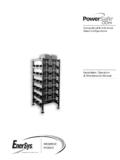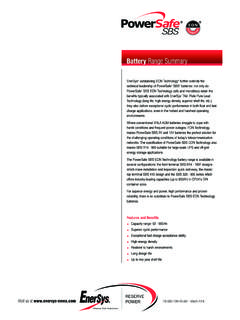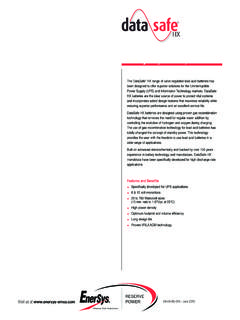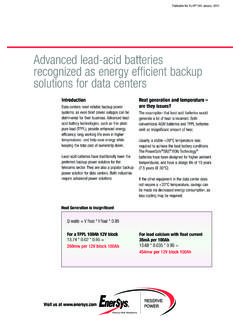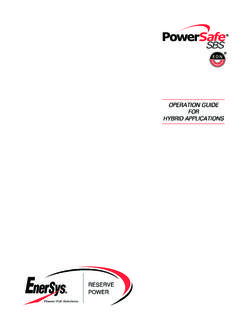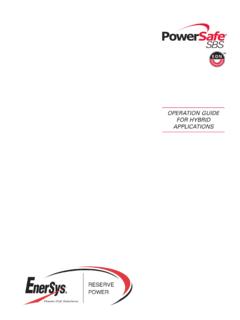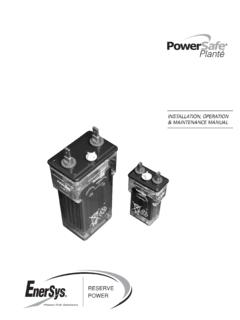Transcription of Instructions for the Safe Handling of Lead-Acid …
1 Instructions for the safe Handling of Lead-Acid Batteries This leaflet was prepared in co-operation with the Committee of Environmental Affairs of eurobat (May 2003), reviewed by eurobat TC members (September 2003) and CEM (October November 2003). Revised Jan 2013. Batteries are considered as articles under REACH regulation 1907/2006/EC and, as such, do not require the publication of a safety data sheet. However, there is a requirement to provide safety information on products. This document, which fulfils this requirement, is commonly called an MSDS, but, in Europe, is more correctly referred to as Instructions for the safe Handling of Lead-Acid Batteries . ENERSYS CUSTOMER CARE PROGRAM 1. Identification of Product and Company Product: RP Lead acid battery Trade name: PowerSafe, DataSafe, SuperSafe, Odyssey, Genesis, Cyclon Manufacturer: EH Europe GmbH Address: L wenstrasse 32, CH-8001 Z rich, Switzerland Phone: Emergency tel.
2 No. +1 703 527 3887 2. Composition and Information on the Main Ingredients 3) CAS no. Description Content 1) [% of weight] Hazard symbol 7439-92-1 Lead Grid (metallic lead, lead alloys with possible traces of additives) ~ 32 T 2) 7439-92-1 Active Mass (battery oxide, inorganic lead compounds) ~ 32 T 2) 7664-93-9 Electrolyte 4) (diluted sulphuric acid with additives) ~ 29 C Plastic Container / Plastic Parts 5) ~ 7 1) Contents may vary due to the design of the battery 2) As result of the harm to the unborn child, lead compounds are classified as toxic for reproduction, Category 1. As this category is not described with a specific hazard symbol, lead compounds have to be labelled with the skull symbol.
3 Lead compounds are not classified toxic . 3) See chapter 12 Ecological Information 4) Density of the electrolyte varies in accordance to the state of charge 5) Composition of the plastic may vary due to different customer requirements 3. Hazards Identification No hazards occur during the normal operation of a lead acid battery as it is described in the Instructions for use that are provided with the battery. Lead-Acid batteries have three significant characteristics: They contain an electrolyte which contains dilute sulphuric acid. Sulphuric acid may cause severe chemical burns. During the charging process or during operation they might develop hydrogen gas and oxygen, which under certain circumstances may result in an explosive mixture.
4 They can contain a considerable amount of energy, which may be a source of high electrical current and a severe electrical shock in the event of a short circuit. Paragraph 15 of the document provides information on the symbols that are displayed on the batteries. 4. First Aid Measures This information is of relevance only if the battery is broken and this results in direct contact with the battery s contents. General Electrolyte (dilute sulphuric acid): sulphuric acid acts corrosively and damages skin Lead compounds: lead compounds are classified as toxic for reproduction (if swallowed) Electrolyte (sulphuric acid) After skin contact: rinse with water, remove and wash wetted clothing After inhalation of acid mist: inhale fresh air, seek advice of a medical doctor After contact with the eyes: rinse under running water for several minutes, seek advice of a medical doctor After swallowing: drink a lot of water immediately, swallow activated carbon, do not induce vomiting, seek advice of a medical doctor Lead compounds After skin contact: clean with water and soap After inhalation.
5 Inhale fresh air, seek advice of a medical doctor After contact with the eyes: rinse under running water for several minutes, seek advice of a medical doctor After swallowing: wash mouth with water, seek advice of a medical doctor 5. Fire Fighting Measures Suitable fire extinguishing agents: CO2 or dry powder extinguishing agents Unsuitable fire extinguishing agents: Water, if the battery voltage is above 120 V Special protective equipment: Protective goggles, respiratory protective equipment, acid protective equipment, acid-proof clothing in case of larger stationary battery plants or where larger quantities are stored. 6. Measures to be Taken in Case of Accidental Release This information is of relevance only if the battery is broken and the contents are released.
6 In the case of spillage, use a bonding agent, such as sand, to absorb spilt acid; use lime / sodium carbonate for neutralisation; dispose of with due regard to the official local regulations; do not allow penetration into the sewage system, into earth or water bodies. 7. Handling and Storage Store under roof in cool ambiance - charged Lead-Acid batteries do not freeze up to -50 C; prevent short circuits. Seek agreement with local water authorities in case of larger quantities of batteries to be stored. If batteries have to be stored, it is imperative that the Instructions for use are observed. 8. Exposure Limits and Personal Protective Equipment Lead and lead compounds No exposure to lead and lead compounds during normal conditions of use.
7 Electrolyte (sulphuric acid) Exposure to sulphuric acid and acid mist might occur during filling and charging. Threshold value in workplace: Occupational exposure limits for sulphuric acid mist are regulated on a national basis. Hazard symbol: C, corrosive Personal protective equipment: Protective goggles, rubber or PVC gloves, acid-resistant clothing, safety boots. CAS-No: 7664-93-9 R-phrases: R-35 Causes severe chemical burns S-phrases: S-2 Keep out of reach of children S-16 Keep away from sparks or naked flame, no smoking S-26 In case of contact with eyes rinse immediately with plenty of water and seek medical advice S-45 In case of accident or if you feel unwell seek medical advice immediately. 9.
8 Physical and Chemical Properties Lead and lead compounds Electrolyte (dilute sulphuric acid, 30 to ) Appearance form: colour: odour: solid grey odourless liquid colourless odourless Safety-related data solidification point: boiling point: solubility in water: density (20 C): vapour pressure (20 C): 327 C 1740 C very low ( mg/l) g/cm -35 to -60 C approx. 108 to 114 C complete to g/cm Lead and lead compounds used in Lead-Acid batteries are poorly soluble in water; lead can be dissolved in an acidic or alkaline environment only. 10. Stability and Reactivity (sulphuric acid, 30 %) Corrosive, non-flammable liquid Thermal decomposition at 338 C Destroys organic materials such as cardboard, wood, textiles Reacts with metals, producing hydrogen Vigorous reactions on contact with sodium hydroxide and alkalis 11.
9 Toxicological Information This information does not apply to the finished product Lead-Acid battery . This information only applies to its compounds in case of a broken product. Different exposure limits exist on a national level. Electrolyte (dilute sulphuric acid) Sulphuric acid is intensely corrosive to skin and mucous membranes; the inhalation of mists may cause damage to the respiratory tract. Acute toxicity data: LD50 (oral, rat) = 2140 mg/kg LC50 (inhalation, rat) = 510 mg/m /2h Lead and lead compounds Lead and its compounds used in a lead acid battery may cause damage to the blood, nerves and kidneys when ingested. The lead contained in the active material is classified as toxic for reproduction.
10 12. Ecological Information This information is of relevance if the battery is broken and the ingredients are released to the environment. Electrolyte (dilute sulphuric acid) In order to avoid damage to the sewage system, the acid has to be neutralised by means of lime or sodium carbonate before disposal. Ecological damage is possible by change of pH. The electrolyte solution reacts with water and organic substances, causing damage to flora and fauna. The electrolyte may also contain soluble components of lead that can be toxic to aquatic environments. Lead and lead compounds Chemical and physical treatment is required for the elimination from water. Waste water containing lead must not be disposed of in an untreated condition.


